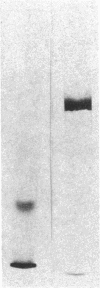Abstract
Binding of various 125I-lipoproteins to hepatic receptors was studied on cultured human hepatoma cells (Hep G2). Chylomicrons, isolated from a chylothorax, chylomicron remnants, hypertriglyceridemic very low-density lipoproteins, normotriglyceridemic very low-density lipoproteins (NTG-VLDL), their remnants, low-density lipoproteins (LDL), and HDL-E (an Apo E-rich high-density lipoprotein isolated from the plasma of a patient with primary biliary cirrhosis) were bound by high-affinity receptors. Chylomicron remnants and HDL-E were bound with the highest affinity. The results, obtained from competitive binding experiments, are consistent with the existence of two distinct receptors on Hep G2 cells: (a) a remnant receptor capable of high-affinity binding of triglyceride-rich lipoproteins and HDL-E, but not of Apo E free LDL, and (b) a LDL receptor capable of high-affinity binding of LDL, NTG-VLDL, and HDL-E. Specific binding of Apo E-free LDL was completely abolished in the presence of 3 mM EDTA, indicating that binding to the LDL receptor is calcium dependent. Specific binding of chylomicron remnants was not inhibited by the presence of even 10 mM EDTA. Preincubation of the Hep G2 cells in lipoprotein-containing medium resulted in complete suppression of LDL receptors but did not affect the remnant receptors. Hep G2 cells seem to be a suitable model for the study of hepatic receptors for lipoprotein in man.
Full text
PDF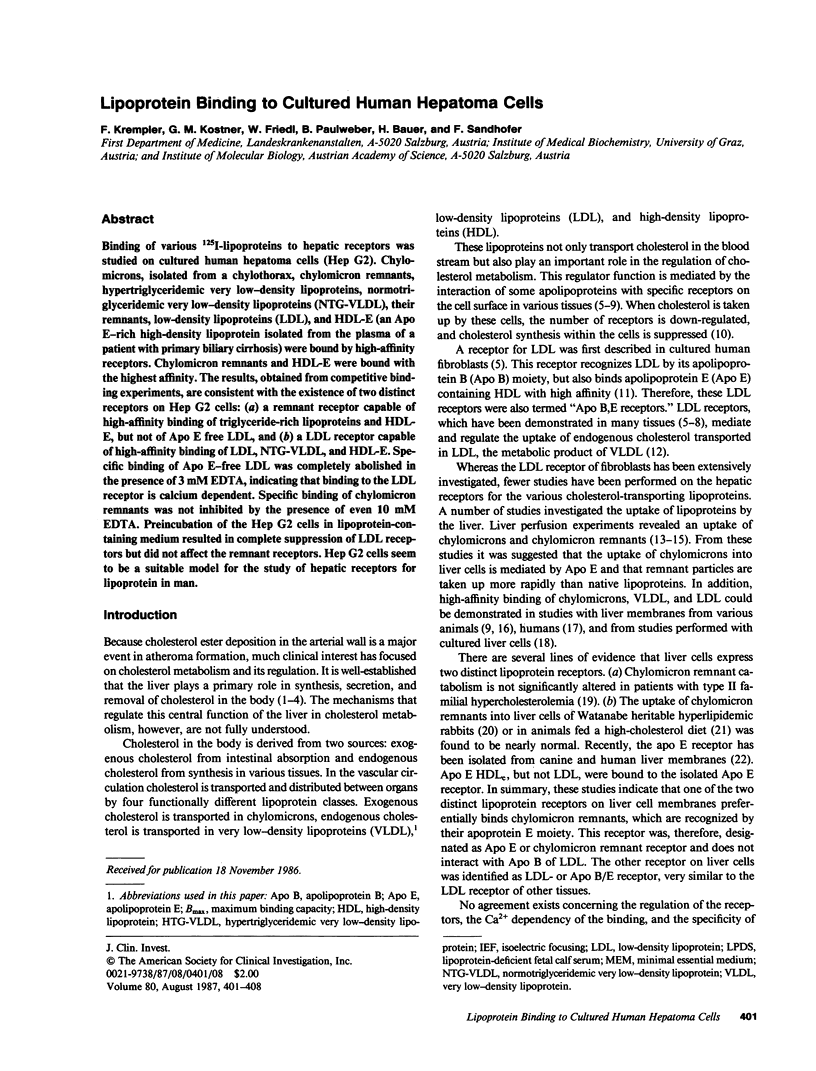
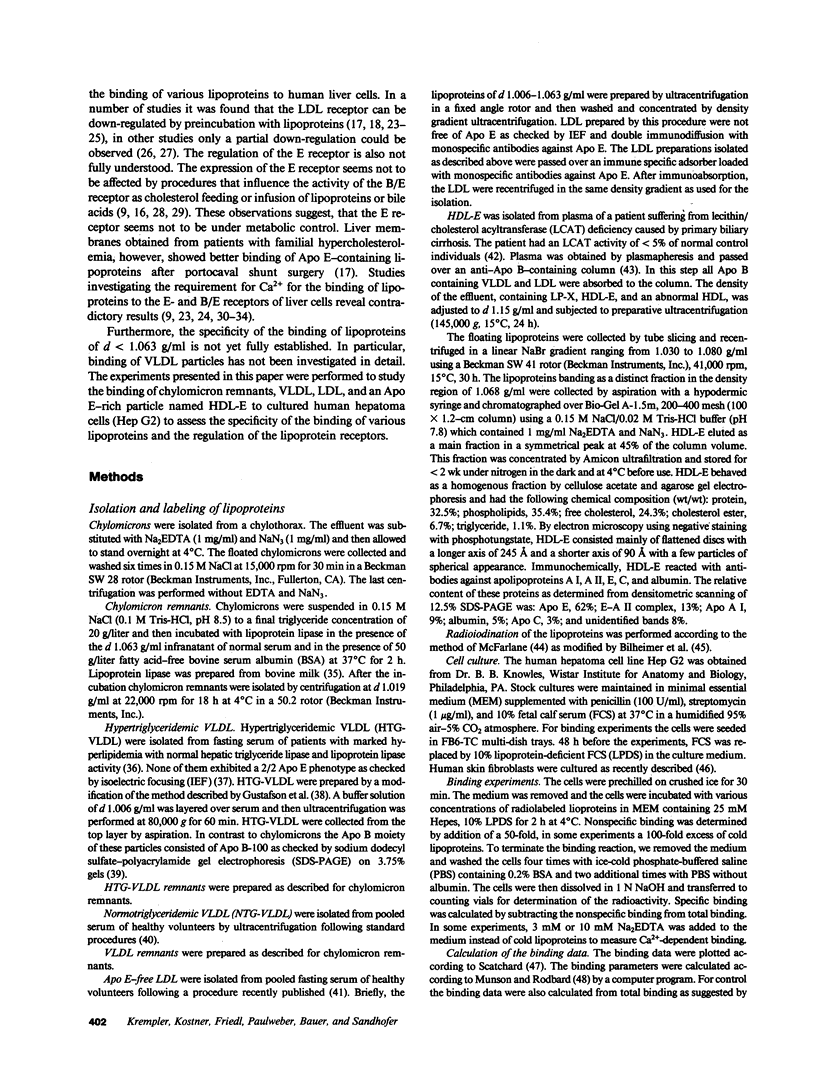
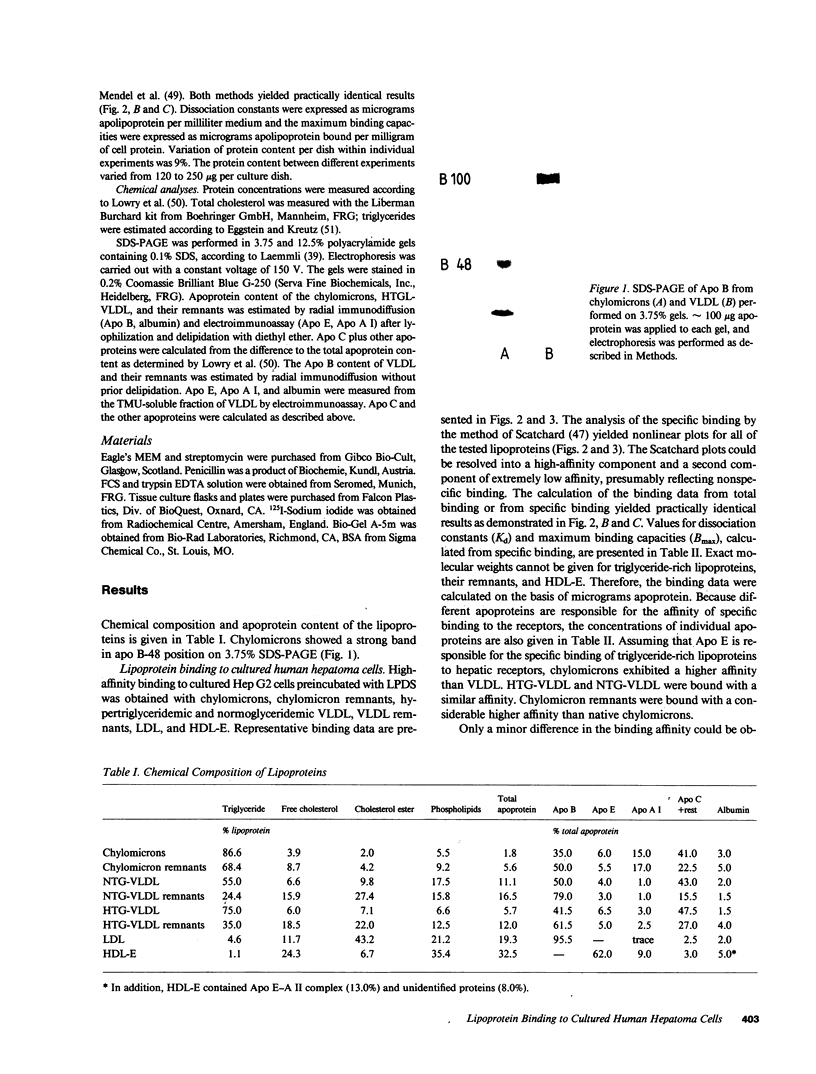
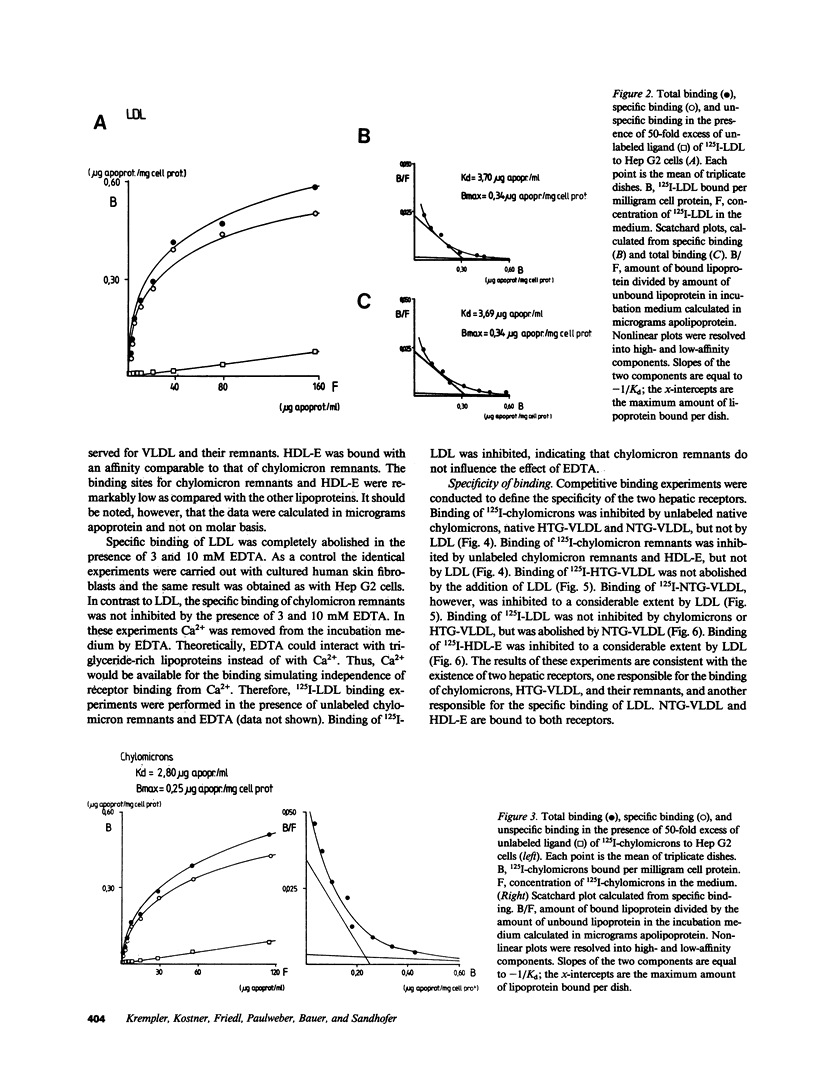

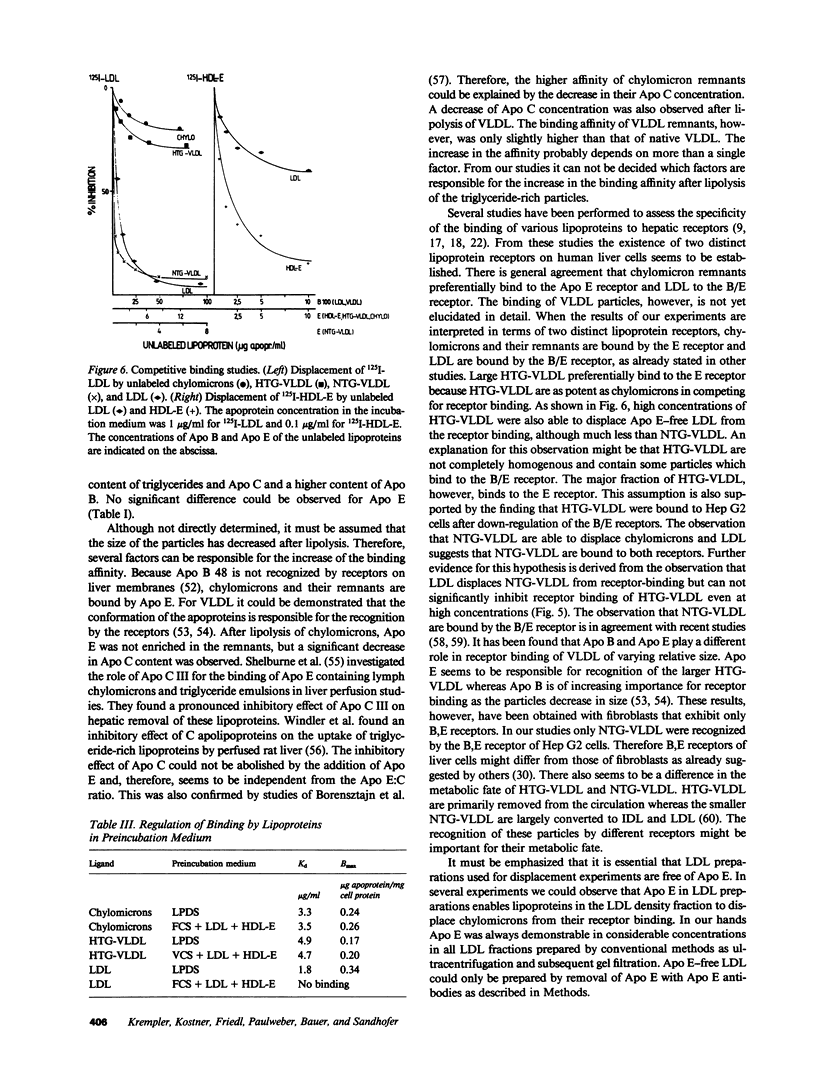
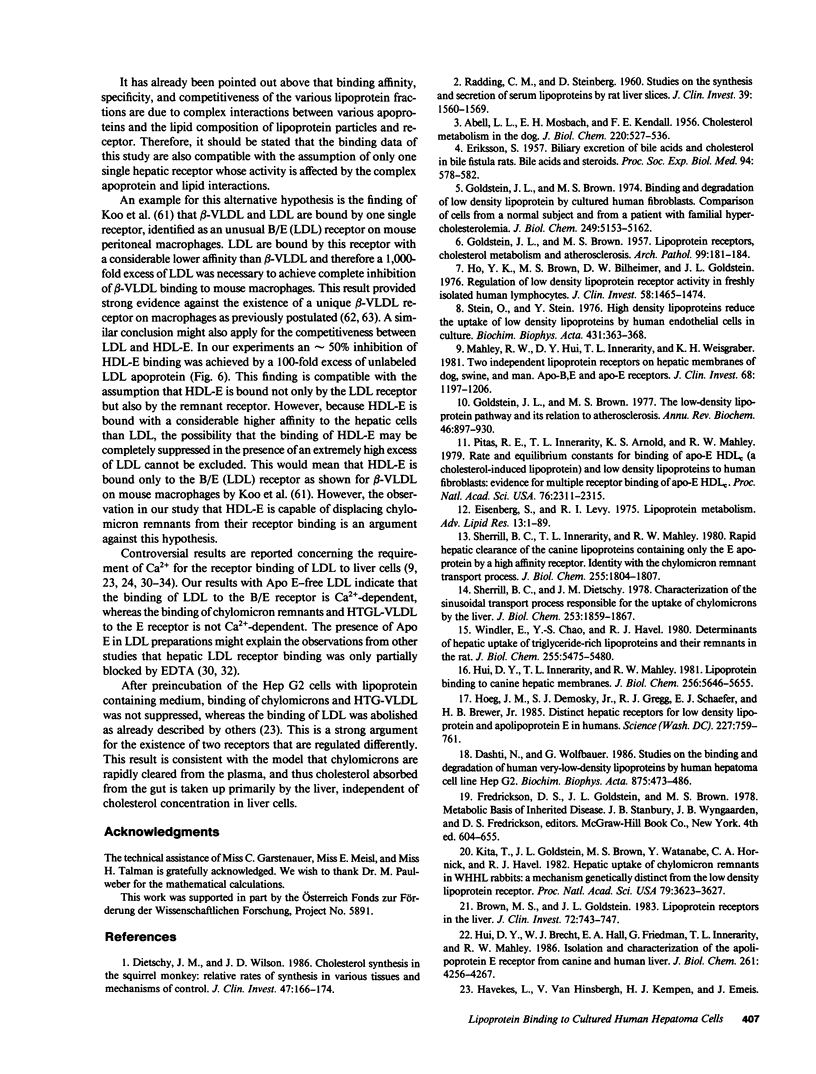
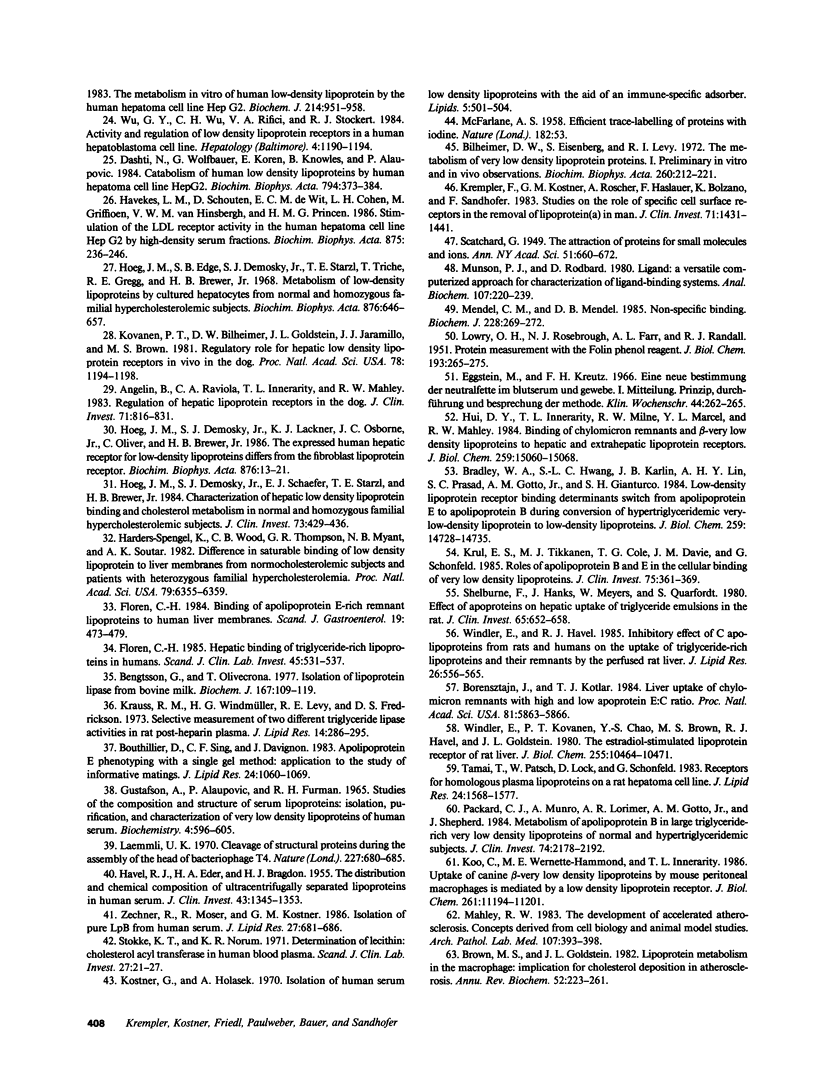
Images in this article
Selected References
These references are in PubMed. This may not be the complete list of references from this article.
- ABELL L. L., MOSBACH E. H., KENDALL F. E. Cholesterol metabolism in the dog. J Biol Chem. 1956 Jun;220(2):527–536. [PubMed] [Google Scholar]
- Angelin B., Raviola C. A., Innerarity T. L., Mahley R. W. Regulation of hepatic lipoprotein receptors in the dog. Rapid regulation of apolipoprotein B,E receptors, but not of apolipoprotein E receptors, by intestinal lipoproteins and bile acids. J Clin Invest. 1983 Apr;71(4):816–831. doi: 10.1172/JCI110835. [DOI] [PMC free article] [PubMed] [Google Scholar]
- Bengtsson G., Olivecrona T. Interaction of lipoprotein lipase with heparin-Sepharose. Evaluation of conditions for affinity binding. Biochem J. 1977 Oct 1;167(1):109–119. doi: 10.1042/bj1670109. [DOI] [PMC free article] [PubMed] [Google Scholar]
- Bilheimer D. W., Eisenberg S., Levy R. I. The metabolism of very low density lipoprotein proteins. I. Preliminary in vitro and in vivo observations. Biochim Biophys Acta. 1972 Feb 21;260(2):212–221. doi: 10.1016/0005-2760(72)90034-3. [DOI] [PubMed] [Google Scholar]
- Borensztajn J., Kotlar T. J. Liver uptake of chylomicron remnants with high and low apoprotein E:C ratios. Proc Natl Acad Sci U S A. 1984 Sep;81(18):5863–5866. doi: 10.1073/pnas.81.18.5863. [DOI] [PMC free article] [PubMed] [Google Scholar]
- Bouthillier D., Sing C. F., Davignon J. Apolipoprotein E phenotyping with a single gel method: application to the study of informative matings. J Lipid Res. 1983 Aug;24(8):1060–1069. [PubMed] [Google Scholar]
- Bradley W. A., Hwang S. L., Karlin J. B., Lin A. H., Prasad S. C., Gotto A. M., Jr, Gianturco S. H. Low-density lipoprotein receptor binding determinants switch from apolipoprotein E to apolipoprotein B during conversion of hypertriglyceridemic very-low-density lipoprotein to low-density lipoproteins. J Biol Chem. 1984 Dec 10;259(23):14728–14735. [PubMed] [Google Scholar]
- Brown M. S., Goldstein J. L. Lipoprotein metabolism in the macrophage: implications for cholesterol deposition in atherosclerosis. Annu Rev Biochem. 1983;52:223–261. doi: 10.1146/annurev.bi.52.070183.001255. [DOI] [PubMed] [Google Scholar]
- Brown M. S., Goldstein J. L. Lipoprotein receptors in the liver. Control signals for plasma cholesterol traffic. J Clin Invest. 1983 Sep;72(3):743–747. doi: 10.1172/JCI111044. [DOI] [PMC free article] [PubMed] [Google Scholar]
- Dashti N., Wolfbauer G., Koren E., Knowles B., Alaupovic P. Catabolism of human low density lipoproteins by human hepatoma cell line HepG2. Biochim Biophys Acta. 1984 Jul 26;794(3):373–384. doi: 10.1016/0005-2760(84)90003-1. [DOI] [PubMed] [Google Scholar]
- Dashti N., Wolfbauer G. Studies on the binding and degradation of human very-low-density lipoproteins by human hepatoma cell line HepG2. Biochim Biophys Acta. 1986 Feb 28;875(3):473–486. doi: 10.1016/0005-2760(86)90067-6. [DOI] [PubMed] [Google Scholar]
- Dietschy J. M., Wilson J. D. Cholesterol synthesis in the squirrel monkey: relative rates of synthesis in various tissues and mechanisms of control. J Clin Invest. 1968 Jan;47(1):166–174. doi: 10.1172/JCI105706. [DOI] [PMC free article] [PubMed] [Google Scholar]
- ERIKSSON S. Biliary excretion of bile acids and cholesterol in bile fistula rats; bile acids and steroids. Proc Soc Exp Biol Med. 1957 Mar;94(3):578–582. doi: 10.3181/00379727-94-23018. [DOI] [PubMed] [Google Scholar]
- Eggstein M., Kreutz F. H. Eine neue Bestimmung der Neutralfette im Blutserum und Gewebe. I. Prinzip, Durchführung und Besprechung der Methode. Klin Wochenschr. 1966 Mar 1;44(5):262–267. doi: 10.1007/BF01747716. [DOI] [PubMed] [Google Scholar]
- Eisenberg S., Levy R. I. Lipoprotein metabolism. Adv Lipid Res. 1975;13:1–89. [PubMed] [Google Scholar]
- Florén C. H. Binding of apolipoprotein E-rich remnant lipoproteins to human liver membranes. Scand J Gastroenterol. 1984 Jun;19(4):473–479. [PubMed] [Google Scholar]
- Florén C. H. Hepatic binding of triglyceride-rich lipoproteins in humans. Scand J Clin Lab Invest. 1985 Oct;45(6):531–537. doi: 10.3109/00365518509155255. [DOI] [PubMed] [Google Scholar]
- GUSTAFSON A., ALAUPOVIC P., FURMAN R. H. STUDIES OF THE COMPOSITION AND STRUCTURE OF SERUM LIPOPROTEINS: ISOLATION, PURIFICATION, AND CHARACTERIZATION OF VERY LOW DENSITY LIPOPROTEINS OF HUMAN SERUM. Biochemistry. 1965 Mar;4:596–605. doi: 10.1021/bi00879a033. [DOI] [PubMed] [Google Scholar]
- Goldstein J. L., Brown M. S. Binding and degradation of low density lipoproteins by cultured human fibroblasts. Comparison of cells from a normal subject and from a patient with homozygous familial hypercholesterolemia. J Biol Chem. 1974 Aug 25;249(16):5153–5162. [PubMed] [Google Scholar]
- Goldstein J. L., Brown M. S. Lipoprotein receptors, cholesterol metabolism, and atherosclerosis. Arch Pathol. 1975 Apr;99(4):181–184. [PubMed] [Google Scholar]
- Goldstein J. L., Brown M. S. The low-density lipoprotein pathway and its relation to atherosclerosis. Annu Rev Biochem. 1977;46:897–930. doi: 10.1146/annurev.bi.46.070177.004341. [DOI] [PubMed] [Google Scholar]
- HAVEL R. J., EDER H. A., BRAGDON J. H. The distribution and chemical composition of ultracentrifugally separated lipoproteins in human serum. J Clin Invest. 1955 Sep;34(9):1345–1353. doi: 10.1172/JCI103182. [DOI] [PMC free article] [PubMed] [Google Scholar]
- Harders-Spengel K., Wood C. B., Thompson G. R., Myant N. B., Soutar A. K. Difference in saturable binding of low density lipoprotein to liver membranes from normocholesterolemic subjects and patients with heterozygous familial hypercholesterolemia. Proc Natl Acad Sci U S A. 1982 Oct;79(20):6355–6359. doi: 10.1073/pnas.79.20.6355. [DOI] [PMC free article] [PubMed] [Google Scholar]
- Havekes L. M., Schouten D., de Wit E. C., Cohen L. H., Griffioen M., van Hinsbergh V. W., Princen H. M. Stimulation of the LDL receptor activity in the human hepatoma cell line Hep G2 by high-density serum fractions. Biochim Biophys Acta. 1986 Feb 12;875(2):236–246. doi: 10.1016/0005-2760(86)90173-6. [DOI] [PubMed] [Google Scholar]
- Havekes L., van Hinsbergh V., Kempen H. J., Emeis J. The metabolism in vitro of human low-density lipoprotein by the human hepatoma cell line Hep G2. Biochem J. 1983 Sep 15;214(3):951–958. doi: 10.1042/bj2140951. [DOI] [PMC free article] [PubMed] [Google Scholar]
- Ho Y. K., Brown S., Bilheimer D. W., Goldstein J. L. Regulation of low density lipoprotein receptor activity in freshly isolated human lymphocytes. J Clin Invest. 1976 Dec;58(6):1465–1474. doi: 10.1172/JCI108603. [DOI] [PMC free article] [PubMed] [Google Scholar]
- Hoeg J. M., Demosky S. J., Jr, Gregg R. E., Schaefer E. J., Brewer H. B., Jr Distinct hepatic receptors for low density lipoprotein and apolipoprotein E in humans. Science. 1985 Feb 15;227(4688):759–761. doi: 10.1126/science.2982214. [DOI] [PubMed] [Google Scholar]
- Hoeg J. M., Demosky S. J., Jr, Lackner K. J., Osborne J. C., Jr, Oliver C., Brewer H. B., Jr The expressed human hepatic receptor for low-density lipoproteins differs from the fibroblast low-density lipoprotein receptor. Biochim Biophys Acta. 1986 Mar 21;876(1):13–21. doi: 10.1016/0005-2760(86)90312-7. [DOI] [PubMed] [Google Scholar]
- Hoeg J. M., Demosky S. J., Jr, Schaefer E. J., Starzl T. E., Brewer H. B., Jr Characterization of hepatic low density lipoprotein binding and cholesterol metabolism in normal and homozygous familial hypercholesterolemic subjects. J Clin Invest. 1984 Feb;73(2):429–436. doi: 10.1172/JCI111229. [DOI] [PMC free article] [PubMed] [Google Scholar]
- Hoeg J. M., Edge S. B., Demosky S. J., Jr, Starzl T. E., Triche T., Gregg R. E., Brewer H. B., Jr Metabolism of low-density lipoproteins by cultured hepatocytes from normal and homozygous familial hypercholesterolemic subjects. Biochim Biophys Acta. 1986 May 21;876(3):646–657. doi: 10.1016/0005-2760(86)90054-8. [DOI] [PMC free article] [PubMed] [Google Scholar]
- Hui D. Y., Brecht W. J., Hall E. A., Friedman G., Innerarity T. L., Mahley R. W. Isolation and characterization of the apolipoprotein E receptor from canine and human liver. J Biol Chem. 1986 Mar 25;261(9):4256–4267. [PubMed] [Google Scholar]
- Hui D. Y., Innerarity T. L., Mahley R. W. Lipoprotein binding to canine hepatic membranes. Metabolically distinct apo-E and apo-B,E receptors. J Biol Chem. 1981 Jun 10;256(11):5646–5655. [PubMed] [Google Scholar]
- Hui D. Y., Innerarity T. L., Milne R. W., Marcel Y. L., Mahley R. W. Binding of chylomicron remnants and beta-very low density lipoproteins to hepatic and extrahepatic lipoprotein receptors. A process independent of apolipoprotein B48. J Biol Chem. 1984 Dec 25;259(24):15060–15068. [PubMed] [Google Scholar]
- Kita T., Goldstein J. L., Brown M. S., Watanabe Y., Hornick C. A., Havel R. J. Hepatic uptake of chylomicron remnants in WHHL rabbits: a mechanism genetically distinct from the low density lipoprotein receptor. Proc Natl Acad Sci U S A. 1982 Jun;79(11):3623–3627. doi: 10.1073/pnas.79.11.3623. [DOI] [PMC free article] [PubMed] [Google Scholar]
- Koo C., Wernette-Hammond M. E., Innerarity T. L. Uptake of canine beta-very low density lipoproteins by mouse peritoneal macrophages is mediated by a low density lipoprotein receptor. J Biol Chem. 1986 Aug 25;261(24):11194–11201. [PubMed] [Google Scholar]
- Kostner G., Holasek A. Isolation of human serum low-density lipoproteins with the aid of an immune-specific adsorber. Lipids. 1970 Jun;5(6):501–504. doi: 10.1007/BF02532735. [DOI] [PubMed] [Google Scholar]
- Kovanen P. T., Bilheimer D. W., Goldstein J. L., Jaramillo J. J., Brown M. S. Regulatory role for hepatic low density lipoprotein receptors in vivo in the dog. Proc Natl Acad Sci U S A. 1981 Feb;78(2):1194–1198. doi: 10.1073/pnas.78.2.1194. [DOI] [PMC free article] [PubMed] [Google Scholar]
- Krauss R. M., Windmueller H. G., Levy R. I., Fredrickson D. S. Selective measurement of two different triglyceride lipase activities in rat postheparin plasma. J Lipid Res. 1973 May;14(3):286–295. [PubMed] [Google Scholar]
- Krempler F., Kostner G. M., Roscher A., Haslauer F., Bolzano K., Sandhofer F. Studies on the role of specific cell surface receptors in the removal of lipoprotein (a) in man. J Clin Invest. 1983 May;71(5):1431–1441. doi: 10.1172/JCI110896. [DOI] [PMC free article] [PubMed] [Google Scholar]
- Krul E. S., Tikkanen M. J., Cole T. G., Davie J. M., Schonfeld G. Roles of apolipoproteins B and E in the cellular binding of very low density lipoproteins. J Clin Invest. 1985 Feb;75(2):361–369. doi: 10.1172/JCI111708. [DOI] [PMC free article] [PubMed] [Google Scholar]
- LOWRY O. H., ROSEBROUGH N. J., FARR A. L., RANDALL R. J. Protein measurement with the Folin phenol reagent. J Biol Chem. 1951 Nov;193(1):265–275. [PubMed] [Google Scholar]
- Laemmli U. K. Cleavage of structural proteins during the assembly of the head of bacteriophage T4. Nature. 1970 Aug 15;227(5259):680–685. doi: 10.1038/227680a0. [DOI] [PubMed] [Google Scholar]
- Mahley R. W. Development of accelerated atherosclerosis. Concepts derived from cell biology and animal model studies. Arch Pathol Lab Med. 1983 Aug;107(8):393–399. [PubMed] [Google Scholar]
- Mahley R. W., Hui D. Y., Innerarity T. L., Weisgraber K. H. Two independent lipoprotein receptors on hepatic membranes of dog, swine, and man. Apo-B,E and apo-E receptors. J Clin Invest. 1981 Nov;68(5):1197–1206. doi: 10.1172/JCI110365. [DOI] [PMC free article] [PubMed] [Google Scholar]
- Mendel C. M., Mendel D. B. 'Non-specific' binding. The problem, and a solution. Biochem J. 1985 May 15;228(1):269–272. doi: 10.1042/bj2280269. [DOI] [PMC free article] [PubMed] [Google Scholar]
- Munson P. J., Rodbard D. Ligand: a versatile computerized approach for characterization of ligand-binding systems. Anal Biochem. 1980 Sep 1;107(1):220–239. doi: 10.1016/0003-2697(80)90515-1. [DOI] [PubMed] [Google Scholar]
- Packard C. J., Munro A., Lorimer A. R., Gotto A. M., Shepherd J. Metabolism of apolipoprotein B in large triglyceride-rich very low density lipoproteins of normal and hypertriglyceridemic subjects. J Clin Invest. 1984 Dec;74(6):2178–2192. doi: 10.1172/JCI111644. [DOI] [PMC free article] [PubMed] [Google Scholar]
- Pitas R. E., Innerarity T. L., Arnold K. S., Mahley R. W. Rate and equilibrium constants for binding of apo-E HDLc (a cholesterol-induced lipoprotein) and low density lipoproteins to human fibroblasts: evidence for multiple receptor binding of apo-E HDLc. Proc Natl Acad Sci U S A. 1979 May;76(5):2311–2315. doi: 10.1073/pnas.76.5.2311. [DOI] [PMC free article] [PubMed] [Google Scholar]
- RADDING C. M., STEINBERG D. Studies on the synthesis and secretion of serum lipoproteins by rat liver slices. J Clin Invest. 1960 Oct;39:1560–1569. doi: 10.1172/JCI104177. [DOI] [PMC free article] [PubMed] [Google Scholar]
- Shelburne F., Hanks J., Meyers W., Quarfordt S. Effect of apoproteins on hepatic uptake of triglyceride emulsions in the rat. J Clin Invest. 1980 Mar;65(3):652–658. doi: 10.1172/JCI109710. [DOI] [PMC free article] [PubMed] [Google Scholar]
- Sherrill B. C., Dietschy J. M. Characterization of the sinusoidal transport process responsible for uptake of chylomicrons by the liver. J Biol Chem. 1978 Mar 25;253(6):1859–1867. [PubMed] [Google Scholar]
- Sherrill B. C., Innerarity T. L., Mahley R. W. Rapid hepatic clearance of the canine lipoproteins containing only the E apoprotein by a high affinity receptor. Identity with the chylomicron remnant transport process. J Biol Chem. 1980 Mar 10;255(5):1804–1807. [PubMed] [Google Scholar]
- Stein O., Stein Y. High density lipoproteins reduce the uptake of low density lipoproteins by human endothelial cells in culture. Biochim Biophys Acta. 1976 May 27;431(2):363–368. doi: 10.1016/0005-2760(76)90157-0. [DOI] [PubMed] [Google Scholar]
- Stokke K. T., Norum K. R. Determination of lecithin: cholesterol acyltransfer in human blood plasma. Scand J Clin Lab Invest. 1971 Feb;27(1):21–27. doi: 10.3109/00365517109080184. [DOI] [PubMed] [Google Scholar]
- Tamai T., Patsch W., Lock D., Schonfeld G. Receptors for homologous plasma lipoproteins on a rat hepatoma cell line. J Lipid Res. 1983 Dec;24(12):1568–1577. [PubMed] [Google Scholar]
- Windler E. E., Kovanen P. T., Chao Y. S., Brown M. S., Havel R. J., Goldstein J. L. The estradiol-stimulated lipoprotein receptor of rat liver. A binding site that membrane mediates the uptake of rat lipoproteins containing apoproteins B and E. J Biol Chem. 1980 Nov 10;255(21):10464–10471. [PubMed] [Google Scholar]
- Windler E., Chao Y., Havel R. J. Determinants of hepatic uptake of triglyceride-rich lipoproteins and their remnants in the rat. J Biol Chem. 1980 Jun 10;255(11):5475–5480. [PubMed] [Google Scholar]
- Windler E., Havel R. J. Inhibitory effects of C apolipoproteins from rats and humans on the uptake of triglyceride-rich lipoproteins and their remnants by the perfused rat liver. J Lipid Res. 1985 May;26(5):556–565. [PubMed] [Google Scholar]
- Wu G. Y., Wu C. H., Rifici V. A., Stockert R. J. Activity and regulation of low density lipoprotein receptors in a human hepatoblastoma cell line. Hepatology. 1984 Nov-Dec;4(6):1190–1194. doi: 10.1002/hep.1840040615. [DOI] [PubMed] [Google Scholar]
- Zechner R., Moser R., Kostner G. M. Isolation of pure LpB from human serum. J Lipid Res. 1986 Jun;27(6):681–686. [PubMed] [Google Scholar]



